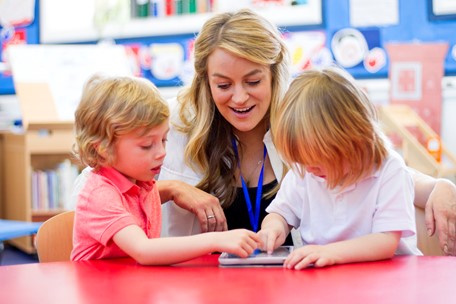By Michael Hilkemeijer
Digital play in the early years is becoming more common in a society where digital technologies are becoming more embedded and ubiquitous in the environment around young children. They are having a profound effect on all aspects of people’s lives that they are now being “taken for granted”.
For young children to become full and capable participants in their environments throughout their schooling and adult lives, it is important they begin to develop their ICT capabilities and become digitally literate.
Additionally, to be effective lifelong learners, young children will need to be literate in the communication modes of their culture and be able to make sense of texts. This could mean developing skills in the use of images and sounds to convey information, ideas and feelings.
The use of technology in early childhood education can be categorised into four key learning areas:
- Communication and collaboration – ICT naturally supports collaborative problem-solving, drawing, video recording or construction. Programmable toys also bring children together and promote language development.
- Creativity – well-designed on-screen applications assume a wide variety of possible responses from young children and through digital play they can experiment and try out many possibilities. This needs to be supported by innovative practitioners.
- Socio-dramatic play – otherwise known as role play, can be benefited immensely from the use of digital technology. As young children observe others in their lives use digital devices, they are beginning to use digital devices themselves and early childhood teachers should encourage this interaction more.
- Learning to learn – there is strong evidence that computers can help young children think about thinking and that when taught correctly by early childhood practitioners, ICT applications can support the development of metacognition – knowing that they know.

13 Ways to Incorporate Digital play in ECE
How is technology used in early childhood education? Young children enter preschool with different levels of capabilities in ICT through their digital play at their home environments. This is a time of exploration, creativity, and learning. Digital play in early childhood learning environments provides more outlets for them to demonstrate their creativity and learning.
Here are 13 ways in which NAEYC says digital technology in early childhood education can be integrated through careful planning and consideration.
- Provide access to multi-touch screens with a wide variety of developmentally appropriate interactive media experiences.
- Provide young children with the opportunities to experience and explore computer mouse and keyboards to use websites and to use search engines.
- Early childhood practitioners can digital cameras to capture block building or artwork; Digital video cameras can be used to capture socio-dramatic play so that it can be replayed for the children;
- Ensure that you celebrate children’s accomplishments with digital media displayed on a digital projector or on a classroom website;
- Carefully choose assistive technologies for young children with disabilities with parents/caregivers as well as the children so to incorporate them into the curriculum;
- Record children’s drawings and their play; make digital audio and video files to document their progress;
- Explore digital storytelling in early childhood education. Co-create digital books with young children of their stories, art, and play. Using apps such as ‘Draw and Tell’ allows children to capture videos, digital still images and record their voices;
- Share ebooks with young children;
- Search digital files for photos of places, people, animals, or objects and converse with children about what they are finding;
- Think about incorporating video conferencing so that young children can communicate and share ideas with others in different early childhood learning environments;
- Arrange play experiences for children to construct and explore their ideas about how technology works.
- Provide access to photographs and experiences children may not otherwise encounter.
